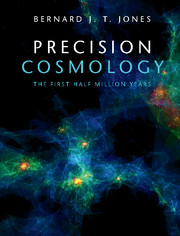Book contents
- Frontmatter
- Dedication
- Contents
- Preface
- Notation and Conventions
- Part I 100 Years of Cosmology
- Part II Newtonian Cosmology
- 5 Newtonian Cosmology
- 6 Dark Energy Cosmological Models
- 7 The Early Universe
- 8 The Inhomogeneous Universe
- 9 The Inflationary Universe
- Part III Relativistic Cosmology
- Part IV The Physics of Matter and Radiation
- Part V Precision Tools for Precision Cosmology
- Appendix A SI, CGS and Planck Units
- Appendix B Magnitudes and Distances
- Appendix C Representing Vectors and Tensors
- Appendix D The Electromagnetic Field
- Appendix E Statistical Distributions
- Appendix F Functions on a Sphere
- Appendix G Acknowledgements
- References
- Index
9 - The Inflationary Universe
from Part II - Newtonian Cosmology
Published online by Cambridge University Press: 04 May 2017
- Frontmatter
- Dedication
- Contents
- Preface
- Notation and Conventions
- Part I 100 Years of Cosmology
- Part II Newtonian Cosmology
- 5 Newtonian Cosmology
- 6 Dark Energy Cosmological Models
- 7 The Early Universe
- 8 The Inhomogeneous Universe
- 9 The Inflationary Universe
- Part III Relativistic Cosmology
- Part IV The Physics of Matter and Radiation
- Part V Precision Tools for Precision Cosmology
- Appendix A SI, CGS and Planck Units
- Appendix B Magnitudes and Distances
- Appendix C Representing Vectors and Tensors
- Appendix D The Electromagnetic Field
- Appendix E Statistical Distributions
- Appendix F Functions on a Sphere
- Appendix G Acknowledgements
- References
- Index
Summary
The concept of the inflationary Universe has become one of the cornerstones of modern cosmology. It describes processes taking place in the very early Universe which may have been responsible for ensuring that the Universe we see today is geometrically flat, and that may provide an explanation for the origin of all the cosmic structures we see. There is no single theory of inflation, but the phenomenon appears to be a feature common to most theories of those very early times that are based on the physics of matter at ultra-high energies as we know it today.
We now have ways of constraining such theories through observations of the cosmic background radiation: the Big Bang has left us its signature. We can look back to ultra-early times and collect archaeological evidence of the Big Bang. This imposes constraints on these fundamental theories and at the same time provides an explanation of how the Universe has come to be the way we observe it.
Inflationary Models
The Pre-inflation Era
Classical physics breaks down at the time when quantum mechanics and general relativity merge: i.e. when the Schwarzschild radius of a volume containing mass MP is on the same order as its Compton wavelength. This determines the size and density of the volume, and the density tells us when in the past history of the Universe this state was achieved: ∽ 5.4 × 10−44 s after the Big Bang. Clearly, physics at or around this time must be regarded as speculative, or simply unverifiable, though that does not stop theoretical physicists from writing papers about it!
If we look some time after the Planck era we are in the era of classical general relativity. During the 1960s, Moscow was a centre for studies of this very early phase of the cosmic expansion with the work of the Khalatnikov group. This culminated in important papers on models for the dynamic evolution of the Universe near the initial singularity by Belinskiǐ and Khalatnikov (1969) and Belinskiǐ, Khalatnikov and Lifshitz (1970, the BKL model). It was during that period that Sakharov wrote the first paper on quantum inhomogeneities in the very early Universe, Sakharov (1966a). In that paper Sakharov addressed the origin of density fluctuations in the framework of a cold Big Bang.
- Type
- Chapter
- Information
- Precision CosmologyThe First Half Million Years, pp. 208 - 234Publisher: Cambridge University PressPrint publication year: 2017



